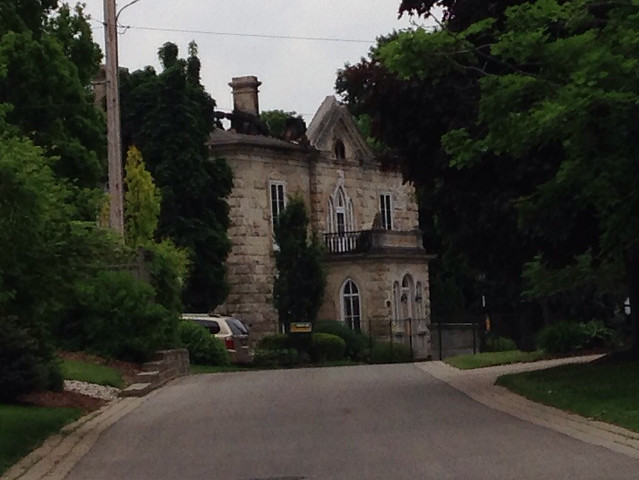A second type of patriotic postcard imposes patriotic decorations on a normal scene. An example of this type can be seen in the card below. It was printed by Warwick Bros & Rutter and was postmarked on 18 Oct. 1904. Typical of early cards, it has an undivided back; that is, the back is reserved entirely for the address of the recipient, leaving only a small space on the front for a message.
The message is a very brief, "Our joint, notice the crowd. Jim." The card is addressed to Miss F. Leslie of St. Marys, Ont.
The photo on the card provides quite a nice view across St. George's Square as it appeared around the turn of the 20th Century. In the foreground is a view of the Blacksmith Fountain with the streetcar paraphernalia surrounding it.
In the background is the old Bank of Montreal building built in 1858 to the designs of architect William Thomas. To its right in the picture is the bank manager's residence, designed in the Chateau style by George Miller in 1892 (Anderson et al., 2000). On the left of the bank lies Quebec St. West with Chalmers and Knox Churches prominently in view.
The Street View photo best corresponding to this view would be the one below:
View Larger Map
The new Bank of Montreal building is visible in the place of the earlier structures, razed in 1961.
The special "Industrial number" of the Guelph Mercury of 1908 has the following to say about the bank:
The Guelph branch was established more than sixty years ago and occupies a handsome stone building which was erected by the bank about half a century ago. This was the first bank established in Guelph, and is one of the strongest and most popular in the city, a condition largely due to the able and conservative business methods under which, for the past ten years, it has been conducted by its manager, Mr. H. Lockwood. He has been identified with this bank for the past 30 years, and is one of its most honored and trusted officials. He is one of Guelph's most representative and substantial business men.The item includes a photograph of Mr. Lockwood.
A Henry Lockwood, age 48, is listed living in Guelph in the 1901 census, along with wife Anne, children Kathleen and Norman, parents William and Eleanor, and Teresa Weiler, a domestic servant. It seems as though the manager's house on St. George's Square was both comfortable and well used.
The image of these fine bank buildings in the postcard, run by substantial, middle-class men, surely captures the image that the Royal City wished to project to the world.
The photograph is framed by patriotic symbols. On the right are the British and Canadian flags along with that odd set, a beaver with a lion and unicorn. On the left is a shield sporting the symbols of all the provinces, along with another Union Jack, topped by an imperial crown and supported with crossed sprigs of maple leaves.
In spite of the heavy use of symbolism, I do not think that the card was intended to celebrate a particular occasion. Printing photographs on paper was a costly process in that era, one that could be reduced in price by printing a smaller photo and in halftone rather than in colour. Coloured drawings could be added to take up the leftover space at relatively little additional expense. So, it is price more than patriotism that may explain the design of this card. Even so, it is an appropriate card for the country's birthday.
That leaves us with the issue of the identities of card's sender and recipient. There is a J. E. Leslie listed as a teller at the Bank of Montreal in the Vernon's City Guide of 1905–07. That is probably "Jim", who is listed as listed as a 15-year old in St. Mary's in the 1901 census as the only son of the six children of John and Mary Leslie. Miss Florence Leslie, 19 years old, is listed as his one of his sisters and is likely the addressee. So, when Jim mentioned "our joint," he did indeed mean the Bank. When he commented ironically on the "the crowd" at the bank (only one figure is visible), was he in jest, or was he another young man a little bored with his clerical job?
Since we are dealing with Canada Day and 1904, it seems appropriate to close with the Dominion Day activities planned in Guelph that year. A short article in the Mercury (30 June) gives the details. The Maple Leaf baseball team was to play a double-header against Galt in Exhibition Park, followed by a concert by the Guelph Musical Society band. As a special treat, there was to be a "throwing contest" between Guelph's Bert King and a "great throwing outfielder" from Galt.
In addition, the 11th and 16th Field Batteries were to stage a mock battle during a break in the morning game, followed by a tug of war between the two units in the afternoon. The winner would receive a silver cup from Adjutant Petrie. (Any relation to A. B. Petrie?) Also, the day would include a raffle in with the following prizes: 1st, a ticket to St. Louis; 2nd, a set of dishes; 3rd, a rocking chair; 4th, a silver cake-basket; and 5th, a lemonade set.
And so it was in the City of Guelph at Canada Day 110 years ago.




